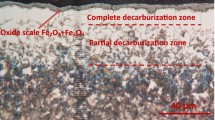Abstract
Low residual-free-oxygen before final de-oxidation was beneficial to improving the cleanness of ultra-low-carbon steel. For ultra-low-carbon steel production, the coordinated control of carbon and oxygen is a precondition for achieving low residual oxygen during the Ruhrstahl Heraeus (RH) decarburization process. In this work, we studied the coordinated control of carbon and oxygen for ultra-low-carbon steel during the basic oxygen furnace (BOF) endpoint and RH process using data statistics, multiple linear regressions, and thermodynamics computations. The results showed that the aluminum yield decreased linearly with increasing residual oxygen in liquid steel. When the mass ratio of free oxygen and carbon ([O]/[C]) in liquid steel before RH decarburization was maintained between 1.5 and 2.0 and the carbon range was from 0.030wt% to 0.040wt%, the residual oxygen after RH natural decarburization was low and easily controlled. To satisfy the requirement for RH decarburization, the carbon and free oxygen at the BOF endpoint should be controlled to be between 297 × 10-6 and 400 × 10-6 and between 574 × 10-6 and 775 × 10-6, respectively, with a temperature of 1695 to 1715°C and a furnace campaign of 1000 to 5000 heats.
Similar content being viewed by others
References
B. Deo, A. Overbosch, B. Snoeijer, D. Das, K. Srinivas, Control of slag formation, foaming, slopping, and chaos in BOF, Trans. Indian Inst. Met., 66(2013), No. 5, p. 543.
B. Deo, A. Karamchetty, A. Paul, P. Singh, and R.P. Chhabra, Characterization of slag-metal droplet-gas emulsion in oxygen steelmaking converters, ISIJ Int., 36(1996), No. 6, p. 658.
G.H. Li, B. Wang, Q. Liu, X.Z. Tian, and R. Zhu, A process model for BOF process based on bath mixing degree, Int. J. Miner. Metall. Mater., 17(2010), No. 6, p. 715.
P.H. Li, Y.P. Bao, F. Yue, and J. Huang, BOF end-point control of ultra low carbon steel, Iron Steel, 46(2011), No. 10, p. 27.
Z.Z. Li, R. Zhu, R.Z. Liu, M. Lu, and H.Z. Wang, Effect of oxygen lance position on the flow velocity of molten steel in BOF, J. Univer. Sci. Technol. Beijing, 36(2014), Suppl. 1, p. 15.
K.D. Schnelle and R.S.H. Mah, Production quality management using a real-time expert system, ISIJ Int., 34(1994), No. 10, p. 815.
L. Liu, Converter control information and its on-line measurement (A), Metall. Ind. Autom., 24(2000), No. 2, p. 5.
K. Feng, H.B. Wang, A.J. Xu, and D.F. He, Endpoint temperature prediction of molten steel in RH using improved case-based reasoning, Int. J. Miner. Metall. Mater., 20(2013), No. 12, p. 1148.
P. Chen and Y.Z. Lu, Mimetic algorithms-based neural network learning for basic oxygen furnace endpoint prediction, J. Zhejiang Univ. Sci. A, 11(2010), No. 11, p. 841.
M.X. Feng, Q. Li, and Z.S. Zou, A outlier identification and judgment method for an improved neural-network BOF forecasting model, Steel Res. Int., 79(2008), No. 5, p. 323.
M. Kanemoto, H. Yamane, T. Yoshida, and H. Tottori, An application of expert system to LD converter processes, ISIJ Int., 30(1990), No. 2, p. 128.
M.A. Ende, Y.M. Kim, M.K. Cho, J.H, Choi, and I.H. Jung, A kinetic model for the Ruhrstahl Heraeus (RH) degassing process, Metall. Mater. Trans. B, 42(2011), No. 3, p. 477.
Y. Higuchi, H. Ikenaga, and Y. Shirota, Effects of [C],[O] and pressure on RH vacuum decarburization, Tetsu-to-Hagnae, 84(1998), No. 10, p. 21.
Y.Q. Sun and Y.Z. Li, Thermodynamical evaluation of calculating formula for activity coefficient of iron oxide, J. Baotou Univ. Iron Steel Technol., 20(2001), No. 3, p. 219.
F.P. Tang, Z. Li, X.F. Wang, B.W. Chen, and P. Fei, Cleaning IF molten steel with dispersed in-situ hetero-phases induces by the composite sphere explosive reaction in RH ladles, Int. J. Miner. Metall. Mater., 18(2011), No. 2, p. 144.
B.S. Liu, G.S. Zhu, H.X. Li, B.H. Li, Y. Cui, and A.M. Cui, Decarburization rate of RH refining for ultra low carbon steel, Int. J. Miner. Metall. Mater., 17(2010), No. 1, p. 22.
J.M. Zhang, L. Liu, X.Y. Zhao, S.W. Lei, and Q.P. Dong, Mathematical model for decarburization process in RH refining process, ISIJ Int., 54(2014), No. 7, p. 1560.
Author information
Authors and Affiliations
Corresponding author
Rights and permissions
About this article
Cite this article
Wang, M., Bao, Yp., Yang, Q. et al. Coordinated control of carbon and oxygen for ultra-low-carbon interstitial-free steel in a smelting process. Int J Miner Metall Mater 22, 1252–1259 (2015). https://doi.org/10.1007/s12613-015-1192-x
Received:
Revised:
Accepted:
Published:
Issue Date:
DOI: https://doi.org/10.1007/s12613-015-1192-x




